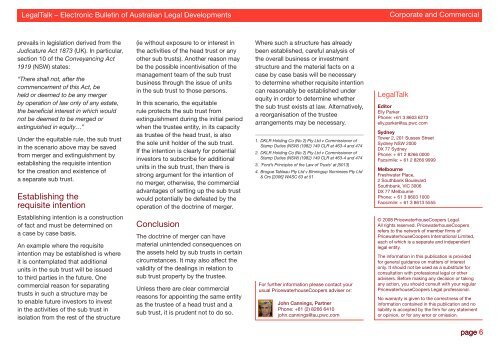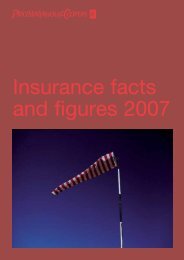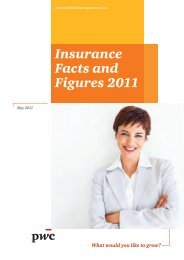LegalTalk - PwC
LegalTalk - PwC
LegalTalk - PwC
You also want an ePaper? Increase the reach of your titles
YUMPU automatically turns print PDFs into web optimized ePapers that Google loves.
<strong>LegalTalk</strong> – Electronic Bulletin of Australian Legal Developments<br />
Corporate and Commercial<br />
prevails in legislation derived from the<br />
Judicature Act 1873 (UK). In particular,<br />
section 10 of the Conveyancing Act<br />
1919 (NSW) states:<br />
“There shall not, after the<br />
commencement of this Act, be<br />
held or deemed to be any merger<br />
by operation of law only of any estate,<br />
the beneficial interest in which would<br />
not be deemed to be merged or<br />
extinguished in equity…”<br />
Under the equitable rule, the sub trust<br />
in the scenario above may be saved<br />
from merger and extinguishment by<br />
establishing the requisite intention<br />
for the creation and existence of<br />
a separate sub trust.<br />
Establishing the<br />
requisite intention<br />
(ie without exposure to or interest in<br />
the activities of the head trust or any<br />
other sub trusts). Another reason may<br />
be the possible incentivisation of the<br />
management team of the sub trust<br />
business through the issue of units<br />
in the sub trust to those persons.<br />
In this scenario, the equitable<br />
rule protects the sub trust from<br />
extinguishment during the initial period<br />
when the trustee entity, in its capacity<br />
as trustee of the head trust, is also<br />
the sole unit holder of the sub trust.<br />
If the intention is clearly for potential<br />
investors to subscribe for additional<br />
units in the sub trust, then there is<br />
strong argument for the intention of<br />
no merger, otherwise, the commercial<br />
advantages of setting up the sub trust<br />
would potentially be defeated by the<br />
operation of the doctrine of merger.<br />
Where such a structure has already<br />
been established, careful analysis of<br />
the overall business or investment<br />
structure and the material facts on a<br />
case by case basis will be necessary<br />
to determine whether requisite intention<br />
can reasonably be established under<br />
equity in order to determine whether<br />
the sub trust exists at law. Alternatively,<br />
a reorganisation of the trustee<br />
arrangements may be necessary.<br />
1. DKLR Holding Co (No 2) Pty Ltd v Commissioner of<br />
Stamp Duties (NSW) (1982) 149 CLR at 463-4 and 474<br />
2. DKLR Holding Co (No 2) Pty Ltd v Commissioner of<br />
Stamp Duties (NSW) (1982) 149 CLR at 463-4 and 474<br />
3. ‘Ford’s Principles of the Law of Trusts’ at [5013]<br />
4. Brogue Tableau Pty Ltd v Binningup Nominees Pty Ltd<br />
& Ors [2006] WASC 63 at 51<br />
<strong>LegalTalk</strong><br />
Editor<br />
Elly Parker<br />
Phone: +61 3 8603 6273<br />
elly.parker@au.pwc.com<br />
Sydney<br />
Tower 2, 201 Sussex Street<br />
Sydney NSW 2000<br />
DX 77 Sydney<br />
Phone: + 61 2 8266 0000<br />
Facsimile: + 61 2 8266 9999<br />
Melbourne<br />
Freshwater Place,<br />
2 Southbank Boulevard<br />
Southbank, VIC 3006<br />
DX 77 Melbourne<br />
Phone: + 61 3 8603 1000<br />
Facsimile: + 61 3 8613 5555<br />
Establishing intention is a construction<br />
of fact and must be determined on<br />
a case by case basis.<br />
An example where the requisite<br />
intention may be established is where<br />
it is contemplated that additional<br />
units in the sub trust will be issued<br />
to third parties in the future. One<br />
commercial reason for separating<br />
trusts in such a structure may be<br />
to enable future investors to invest<br />
in the activities of the sub trust in<br />
isolation from the rest of the structure<br />
Conclusion<br />
The doctrine of merger can have<br />
material unintended consequences on<br />
the assets held by sub trusts in certain<br />
circumstances. It may also affect the<br />
validity of the dealings in relation to<br />
sub trust property by the trustee.<br />
Unless there are clear commercial<br />
reasons for appointing the same entity<br />
as the trustee of a head trust and a<br />
sub trust, it is prudent not to do so.<br />
For further information please contact your<br />
usual PricewaterhouseCoopers adviser or:<br />
John Cannings, Partner<br />
Phone: +61 (2) 8266 6410<br />
john.cannings@au.pwc.com<br />
© 2008 PricewaterhouseCoopers Legal.<br />
All rights reserved. PricewaterhouseCoopers<br />
refers to the network of member firms of<br />
PricewaterhouseCoopers International Limited,<br />
each of which is a separate and independent<br />
legal entity.<br />
The information in this publication is provided<br />
for general guidance on matters of interest<br />
only. It should not be used as a substitute for<br />
consultation with professional legal or other<br />
advisers. Before making any decision or taking<br />
any action, you should consult with your regular<br />
PricewaterhouseCoopers Legal professional.<br />
No warranty is given to the correctness of the<br />
information contained in this publication and no<br />
liability is accepted by the firm for any statement<br />
or opinion, or for any error or omission.<br />
page
















